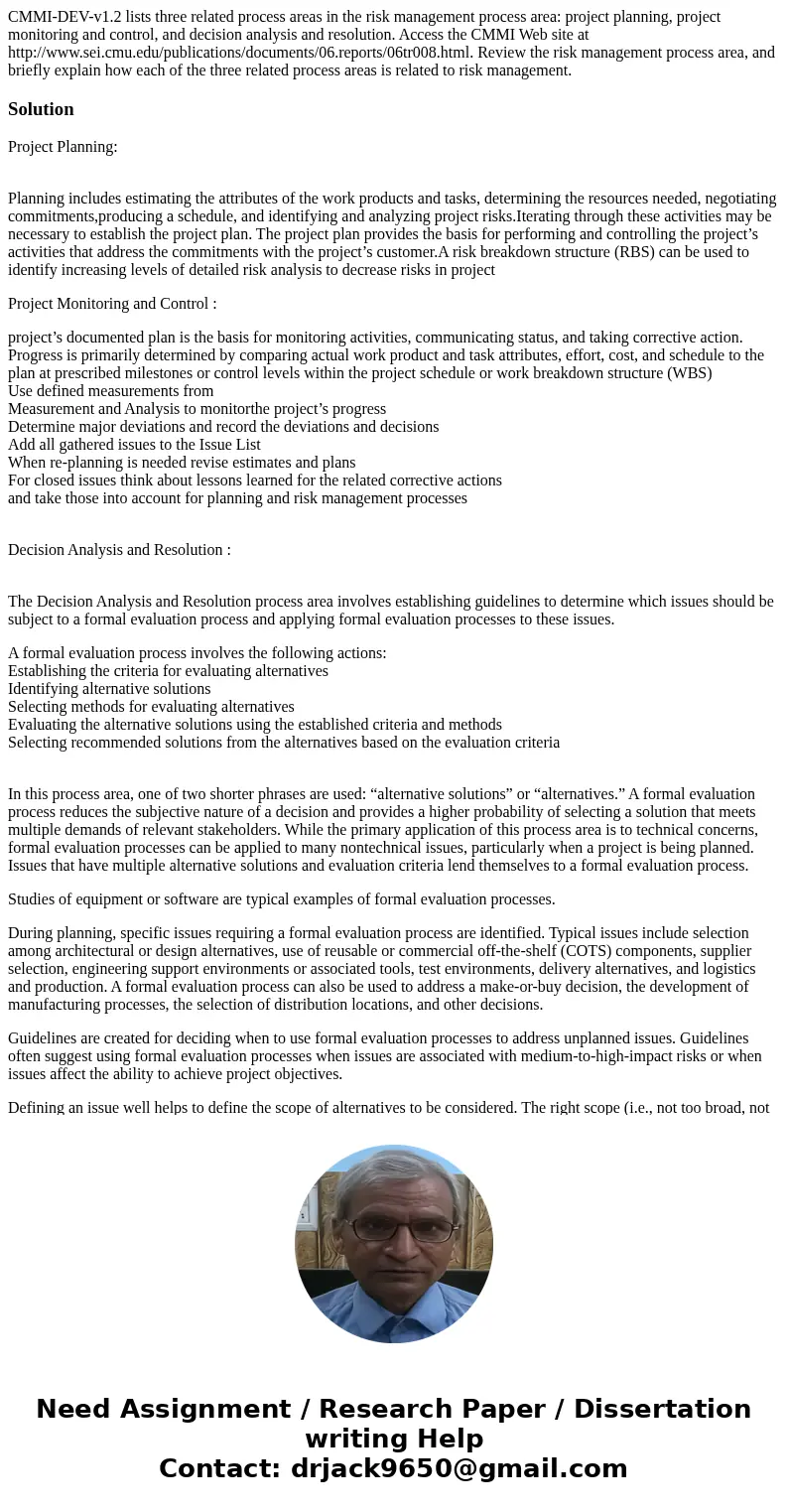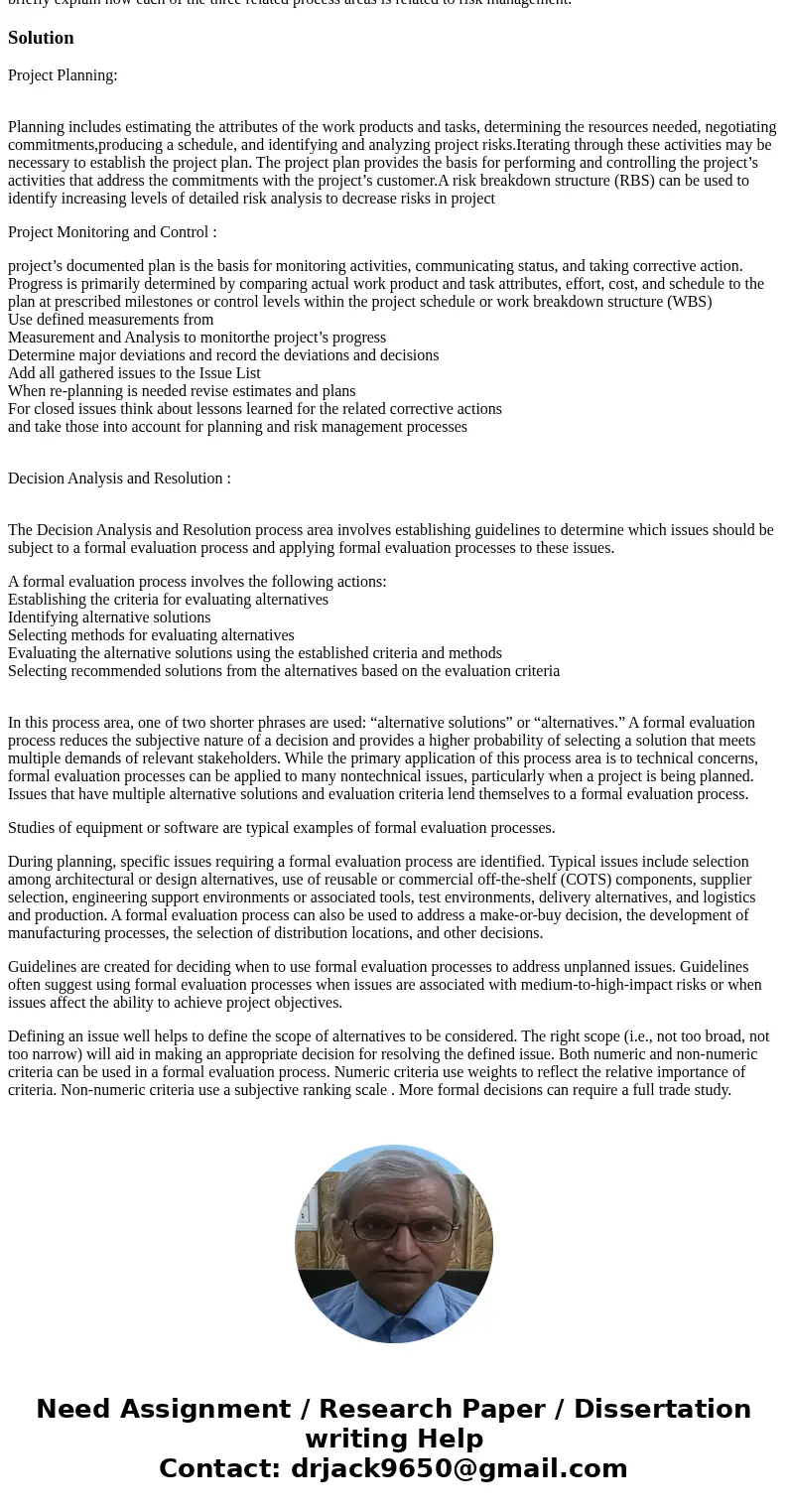CMMIDEVv12 lists three related process areas in the risk man
CMMI-DEV-v1.2 lists three related process areas in the risk management process area: project planning, project monitoring and control, and decision analysis and resolution. Access the CMMI Web site at http://www.sei.cmu.edu/publications/documents/06.reports/06tr008.html. Review the risk management process area, and briefly explain how each of the three related process areas is related to risk management.
Solution
Project Planning:
Planning includes estimating the attributes of the work products and tasks, determining the resources needed, negotiating commitments,producing a schedule, and identifying and analyzing project risks.Iterating through these activities may be necessary to establish the project plan. The project plan provides the basis for performing and controlling the project’s activities that address the commitments with the project’s customer.A risk breakdown structure (RBS) can be used to identify increasing levels of detailed risk analysis to decrease risks in project
Project Monitoring and Control :
project’s documented plan is the basis for monitoring activities, communicating status, and taking corrective action. Progress is primarily determined by comparing actual work product and task attributes, effort, cost, and schedule to the plan at prescribed milestones or control levels within the project schedule or work breakdown structure (WBS)
Use defined measurements from
Measurement and Analysis to monitorthe project’s progress
Determine major deviations and record the deviations and decisions
Add all gathered issues to the Issue List
When re-planning is needed revise estimates and plans
For closed issues think about lessons learned for the related corrective actions
and take those into account for planning and risk management processes
Decision Analysis and Resolution :
The Decision Analysis and Resolution process area involves establishing guidelines to determine which issues should be subject to a formal evaluation process and applying formal evaluation processes to these issues.
A formal evaluation process involves the following actions:
Establishing the criteria for evaluating alternatives
Identifying alternative solutions
Selecting methods for evaluating alternatives
Evaluating the alternative solutions using the established criteria and methods
Selecting recommended solutions from the alternatives based on the evaluation criteria
In this process area, one of two shorter phrases are used: “alternative solutions” or “alternatives.” A formal evaluation process reduces the subjective nature of a decision and provides a higher probability of selecting a solution that meets multiple demands of relevant stakeholders. While the primary application of this process area is to technical concerns, formal evaluation processes can be applied to many nontechnical issues, particularly when a project is being planned. Issues that have multiple alternative solutions and evaluation criteria lend themselves to a formal evaluation process.
Studies of equipment or software are typical examples of formal evaluation processes.
During planning, specific issues requiring a formal evaluation process are identified. Typical issues include selection among architectural or design alternatives, use of reusable or commercial off-the-shelf (COTS) components, supplier selection, engineering support environments or associated tools, test environments, delivery alternatives, and logistics and production. A formal evaluation process can also be used to address a make-or-buy decision, the development of manufacturing processes, the selection of distribution locations, and other decisions.
Guidelines are created for deciding when to use formal evaluation processes to address unplanned issues. Guidelines often suggest using formal evaluation processes when issues are associated with medium-to-high-impact risks or when issues affect the ability to achieve project objectives.
Defining an issue well helps to define the scope of alternatives to be considered. The right scope (i.e., not too broad, not too narrow) will aid in making an appropriate decision for resolving the defined issue. Both numeric and non-numeric criteria can be used in a formal evaluation process. Numeric criteria use weights to reflect the relative importance of criteria. Non-numeric criteria use a subjective ranking scale . More formal decisions can require a full trade study.


 Homework Sourse
Homework Sourse